Mushrooms are in abundance at the moment and through this piece we’ll be looking at the Top Five Mushrooms to Forage in November. Any walk through a green space or forest will have you tripping over some sort of Fungi and there is so much variety! Here I want to outline five mushrooms you will definitely come across this November and whether they are safe or not. I have added some links to more in depth guides to help you to learn more about what’s out there and to keep you from making any mistakes!
Wood Blewit – Clitocybe/Lepista Nuda : Tasty
This has to be one of my favourite mushrooms to find at this time of year as not only is it a great eater but it is also a great looking mushroom. It has that beautiful purple hue that is worrying to most but joyous to some! Cook well!
- Buff brown caps with a violet tinge, the surface of the cap is almost translucent and you can often see lines when maggots have nibbled the flesh
- With age the cap can become wavy at the edge and funnel shaped
- The gills are a pale violet colour, crowded and sinuate.
- The stem often has a faint vertical striated pattern leading down to a bulbous base which has often got fluffy white mycelium attached.
- This mushroom has a slightly perfumy smell and a pinkish white spore print.
For more details on Wood Blewits click here
Sulphur tuft -Hypholoma fasciculare: Trouble
I have heard it said that you’re not foraging unless you find this mushroom. It’s probably one of the most if not the most common mushroom to find and sadly is not edible. This will give you a bad stomach ache at one end and maybe put you in hospital if you eat enough of them. You will have likely seen thousands of these all crammed onto one stump, glowing bright yellow in the autumn sun!
- Conical cap sulphur yellow paling towards the edge aging to yellow/brown. Slight remains of veil often left hanging from the edges.
- Crowded sulphur gills yellow becoming olive/green/brown and darkening..
- Stem is sulphur yellow, darker at the base, pale towards the cap. Usually curved as the stem tends to start growing horizontally from a tree stump.
- Grows on most types of tree stumps in large clusters.
For more details on Sulphur tuft click here
The Blusher – Amanita Rubescens: Tasty (But be careful now)
Part of the Amanita Family, this beautiful mushroom is highly poisonous if not cooked properly. This in my opinion is not a beginner mushroom but it is a great one for learning when to look for details in individual mushrooms. As the only thing that truly separates this mushroom from a potentially deadly one is in the details.
- The cap is buff brown to a pinkish brown colour, with movable white spots. ranging from 5_20cm across. the cap is domed shaped when young becoming very slightly funnel shaped with age.
- The gills are crouded and not quite touching the stem. The gills are white in colour but have pinkish red spots where insects have damaged them.
- The stem has a striped white veil (skirt), the stem is between 1-2cm in diameter and is white above the veil becoming darker brown toward the base with small scales.
- The base is bulbous with scales which is the remnants of the egg which the mushroom grew from.
- The Busher will have a white spore print
For more detailed information on Blushers click here
The Winter Chanterelle – Cantherellus tubaeformis : (Very tasty)
This is a fantastic mushroom, a great looking trumpet shaped fungi with a strong flavour and great potential. As the name suggests this mushroom like to pop up towards the end of the season around the same time as the wood blewit. It too likes to hide in leaf litter but grows in such abundance when found
- Cap is convex with a depression in the centre when young becoming funnel-shaped with irregular edges. A hole in the centre can run right through to the hollow stem. Dark yellow/brown to orange/yellow.
- Gills are pale yellow/brown. Not crowded, irregularly branching and running down the stem, these are not true gills but folds.
- Yellow, cylindrical to irregular and hollow Stem. Can have a vertical depression making the stem look like a pair of yellow legs.
- Found in ,mixed woodland and coniferous forest on moss or rotting wood. Found more in mossy Beech woods.
Click here for more details on the Winter chanterelle.
The Death Cap – Amanita phalloides:(Do not eat under any circumstances!!)
It wouldn’t be mushroom hunting without a nice sprinkling of danger and this mushroom provides it in droves! The Death Cap lives up to its name and is easily the deadliest fungi growing in the UK today. It isn’t particularly scary looking and infact it looks relatively innocuous, until you eat it….. Which you should NEVER do as this mushroom can kill you in 6 hours.
- Like all amanita this mushroom grows from a volva (egg sack)
- The cap is olive-brown and quite shiny, it doesn’t have any warts or spots but does look fibrous towards the edge of the cap. Its often darker in the centre of the cap. Dome shaped when young and flattening with age, the edge is prone to splitting when dry.
- The gills are crowded and white, they are adnext (narrowly joined to the stem) with age the gills begin to turn more of a creamy colour
- The tall stem is creamy coloured with zig zag like scales, it has a large striped veil (skirt).
- The base is surrounded by the white volva (egg sack)
- Slight sweet floral smell, becoming sickly as it matures



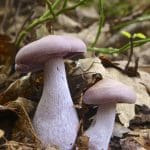
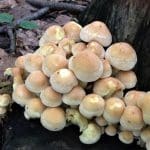
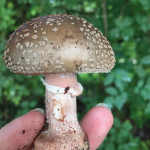
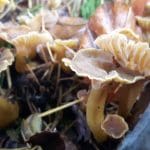
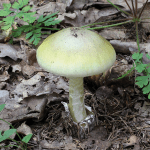



Leave a Reply
You must be logged in to post a comment.